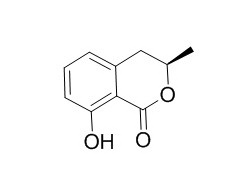Mellein
Standard reference
Inquire / Order:
manager@chemfaces.com
Technical Inquiries:
service@chemfaces.com
Tel:
+86-27-84237783
Fax:
+86-27-84254680
Address:
1 Building, No. 83, CheCheng Rd., Wuhan Economic and Technological Development Zone, Wuhan, Hubei 430056, PRC
Providing storage is as stated on the product vial and the vial is kept tightly sealed, the product can be stored for up to
24 months(2-8C).
Wherever possible, you should prepare and use solutions on the same day. However, if you need to make up stock solutions in advance, we recommend that you store the solution as aliquots in tightly sealed vials at -20C. Generally, these will be useable for up to two weeks. Before use, and prior to opening the vial we recommend that you allow your product to equilibrate to room temperature for at least 1 hour.
Need more advice on solubility, usage and handling? Please email to: service@chemfaces.com
The packaging of the product may have turned upside down during transportation, resulting in the natural compounds adhering to the neck or cap of the vial. take the vial out of its packaging and gently shake to let the compounds fall to the bottom of the vial. for liquid products, centrifuge at 200-500 RPM to gather the liquid at the bottom of the vial. try to avoid loss or contamination during handling.
J Ethnopharmacol.2024, 335:118628.
Int Immunopharmacol.2021, 100:108073.
Food Chem.2022, 373(Pt B):131364.
bioRxiv2021, 458409.
Journal of Molecular Liquids2021, 334:116014.
Molecules.2019, 24(24),4583
Biosci Rep.2020, 40(8):BSR20201219.
Biochem Biophys Res Commun.2018, 495(1):1271-1277
J Pharm Biomed Anal.2018, 151:32-41
Phytochemistry.2024, 222:114102.
Related and Featured Products
Appl Environ Microbiol. 2015 Jan;81(1):177-86.
An in planta-expressed polyketide synthase produces (R)-mellein in the wheat pathogen Parastagonospora nodorum.[Pubmed:
25326302 ]
Parastagonospora nodorum is a pathogen of wheat that affects yields globally.
METHODS AND RESULTS:
Previous transcriptional analysis identified a partially reducing polyketide synthase (PR-PKS) gene, SNOG_00477 (SN477), in P. nodorum that is highly upregulated during infection of wheat leaves. Disruption of the corresponding SN477 gene resulted in the loss of production of two compounds, which we identified as (R)-Mellein and (R)-O-methylMellein. Using a Saccharomyces cerevisiae yeast heterologous expression system, we successfully demonstrated that SN477 is the only enzyme required for the production of (R)-Mellein. This is the first identification of a fungal PKS that is responsible for the synthesis of (R)-Mellein. The P. nodorum ΔSN477 mutant did not show any significant difference from the wild-type strain in its virulence against wheat. However, (R)-Mellein at 200 μg/ml inhibited the germination of wheat (Triticum aestivum) and barrel medic (Medicago truncatula) seeds. Comparative sequence analysis identified the presence of Mellein synthase (MLNS) homologues in several Dothideomycetes and two sodariomycete genera.
CONCLUSIONS:
Phylogenetic analysis suggests that the MLNSs in fungi and bacteria evolved convergently from fungal and bacterial 6-methylsalicylic acid synthases.
J Am Chem Soc. 2012 Jul 25;134(29):11924-7.
Synthesis of (R)-mellein by a partially reducing iterative polyketide synthase.[Pubmed:
22793256]
Disruption of the corresponding SN477 gene resulted in the loss of production of two compounds, which we identified as (R)-Mellein and (R)-O-methylMellein.
METHODS AND RESULTS:
Using a Saccharomyces cerevisiae yeast heterologous expression system, we successfully demonstrated that SN477 is the only enzyme required for the production of (R)-Mellein. This is the first identification of a fungal PKS that is responsible for the synthesis of (R)-Mellein. The P. nodorum ΔSN477 mutant did not show any significant difference from the wild-type strain in its virulence against wheat. However, (R)-Mellein at 200 μg/ml inhibited the germination of wheat (Triticum aestivum) and barrel medic (Medicago truncatula) seeds. Comparative sequence analysis identified the presence of Mellein synthase (MLNS) homologues in several Dothideomycetes and two sodariomycete genera.
CONCLUSIONS:
Phylogenetic analysis suggests that the MLNSs in fungi and bacteria evolved convergently from fungal and bacterial 6-methylsalicylic acid synthases.



